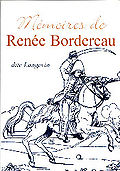
Renée Bordereau
Encyclopedia

Anjou
Anjou is a former county , duchy and province centred on the city of Angers in the lower Loire Valley of western France. It corresponds largely to the present-day département of Maine-et-Loire...
, was a French
France
The French Republic , The French Republic , The French Republic , (commonly known as France , is a unitary semi-presidential republic in Western Europe with several overseas territories and islands located on other continents and in the Indian, Pacific, and Atlantic oceans. Metropolitan France...
woman who disguised herself as a man and fought as a Royalist
House of Bourbon
The House of Bourbon is a European royal house, a branch of the Capetian dynasty . Bourbon kings first ruled Navarre and France in the 16th century. By the 18th century, members of the Bourbon dynasty also held thrones in Spain, Naples, Sicily, and Parma...
cavalier
Cavalry
Cavalry or horsemen were soldiers or warriors who fought mounted on horseback. Cavalry were historically the third oldest and the most mobile of the combat arms...
in the troops of Charles Melchior Artus de Bonchamps
Charles Melchior Artus de Bonchamps
Charles-Melchior Arthus, Marquis de Bonchamps was a French politician and leader of the Vendéan insurrection of Royalists against the Republic during the French Revolution....
during the Vendéan insurrection
Revolt in the Vendée
The War in the Vendée was a Royalist rebellion and counterrevolution in the Vendée region of France during the French Revolution. The Vendée is a coastal region, located immediately south of the Loire River in western France. The uprising was closely tied to the Chouannerie, which took place in...
against the French Revolution
French Revolution
The French Revolution , sometimes distinguished as the 'Great French Revolution' , was a period of radical social and political upheaval in France and Europe. The absolute monarchy that had ruled France for centuries collapsed in three years...
(in 1793).
She is reputed to have killed some twenty of the opposing revolutionary Bleues
French Revolutionary Army
The French Revolutionary Army is the term used to refer to the military of France during the period between the fall of the ancien regime under Louis XVI in 1792 and the formation of the First French Empire under Napoleon Bonaparte in 1804. These armies were characterised by their revolutionary...
with her own hands. A unit led by her threw six hundred Republican soldiers from the heights of Roche-de-Mûrs in the commune of Mûrs-Erigné
Mûrs-Erigné
Mûrs-Erigné is a commune in the Maine-et-Loire department in western France.-See also:*Communes of the Maine-et-Loire department...
, south of the town of Angers
Angers
Angers is the main city in the Maine-et-Loire department in western France about south-west of Paris. Angers is located in the French region known by its pre-revolutionary, provincial name, Anjou, and its inhabitants are called Angevins....
, Pays de la Loire
Pays de la Loire
Pays de la Loire is one of the 27 regions of France. It is one of the regions created in the late 20th century to serve as a zone of influence for its capital, Nantes, one of a handful so-called "balancing metropolises" ¹...
, into the Louet River below.
Her effectiveness is as a soldier is attested by independent sources, including Madame de La Rochejaquelein, who reported "She was of ordinary height and very ugly. One day at Cholet, they pointed her out to me. 'See that soldier who has sleeves of a color different from his coat. That's a girl who fights like a lion.'... Her unbelievable courage was celebrated throughout the whole army.":: From Marilyn Yalom, Blood Sisters: The French Revolution in Women's Memory, Basic Books, 1993, p. 201.
Of one of her own experiences, Bordereau wrote: "Arriving near the Loire, I destroyed five of my enemies, and finishing off the day, I broke my sword on the head of the last one... Seeing only one horseman near me, I doubled back to our army. I alone, killed twenty-one that day. I'm not the one who counted them, but those who followed me, and if they hadn't said so, I wouldn't have spoken about it myself.":: From Yalom, p. 199
Quotes
- "Renée Bordereau, whose father was butchered before her eyes, and who lost forty-two relatives in the civil war of La Vendee; during the course of six years fought in more than two hundred battles, on foot and on horseback, with the most determined intrepidity. In one battle she killed twenty-one of the enemy. She liberated fifty priests at one time and eight hundred at another, all of whom would have been executed. A price of 40,000 francsFrench francThe franc was a currency of France. Along with the Spanish peseta, it was also a de facto currency used in Andorra . Between 1360 and 1641, it was the name of coins worth 1 livre tournois and it remained in common parlance as a term for this amount of money...
was set on her head. She was thrown into prison for a crime for which she could only prove her innocence by a discovery of her sex, where she remained five years, until the accession of Louis EighteenthLouis XVIII of FranceLouis XVIII , known as "the Unavoidable", was King of France and of Navarre from 1814 to 1824, omitting the Hundred Days in 1815...
to the throne of France."
-
- From Hit by Mary E. Walker, M. D., pp. 130, 131, New York:The American News Company: 1871.

